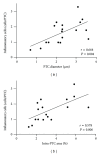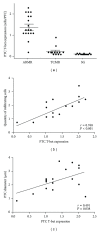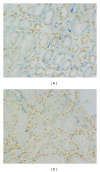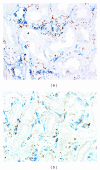Capillary dilation and rarefaction are correlated with intracapillary inflammation in antibody-mediated rejection
- PMID: 24741607
- PMCID: PMC3987932
- DOI: 10.1155/2014/582902
Capillary dilation and rarefaction are correlated with intracapillary inflammation in antibody-mediated rejection
Abstract
Antibody-mediated rejection (ABMR) remains one of the major causes of graft loss after renal transplantation. It is dominated by endothelial damage in microcirculation. Clarifying the mechanism of microcirculating damage is obviously a key step to understand the pathogenesis of ABMR. Here we characterized capillary variation in ABMR and its possible mechanisms. Compared with T cell-mediated rejection and stable grafts, there was a significant dilation and rarefaction in peritubular capillaries (PTCs) of the ABMR group; Image-Pro Plus revealed a significantly larger intra-PTC area. Interestingly, the dilation of PTCs was strongly correlated with the intra-PTC cell counting. Moreover, peritubular capillary inflammation is correlated with in situ T-bet expression, and there was a good correlation between the intra-PTC expression of T-bet and the PTC diameter. HIF-1α up-regulation could be observed in ABMR but it was not necessary for capillary dilation. In general, ABMR is characterized with early capillary dilation and rarefaction; our data confirmed that the dilation is strongly correlated with intracapillary inflammation, which in turn is correlated with in situ T-bet expression. T-bet plays an important role in the development of microcirculating injury, and thus it is a potential target for the treatment of ABMR.
Figures





Similar articles
-
Current pathological perspectives on chronic rejection in renal allografts.Clin Exp Nephrol. 2017 Dec;21(6):943-951. doi: 10.1007/s10157-016-1361-x. Epub 2016 Nov 16. Clin Exp Nephrol. 2017. PMID: 27848058 Review.
-
The diagnostic value of transcription factors T-bet/GATA3 ratio in predicting antibody-mediated rejection.Clin Dev Immunol. 2013;2013:460316. doi: 10.1155/2013/460316. Epub 2013 Oct 23. Clin Dev Immunol. 2013. PMID: 24235972 Free PMC article.
-
Capillary C4d and Kidney Allograft Outcome in Relation to Morphologic Lesions Suggestive of Antibody-Mediated Rejection.Clin J Am Soc Nephrol. 2015 Aug 7;10(8):1435-43. doi: 10.2215/CJN.09901014. Epub 2015 Jun 12. Clin J Am Soc Nephrol. 2015. PMID: 26071493 Free PMC article.
-
C5b9 Deposition in Glomerular Capillaries Is Associated With Poor Kidney Allograft Survival in Antibody-Mediated Rejection.Front Immunol. 2019 Mar 8;10:235. doi: 10.3389/fimmu.2019.00235. eCollection 2019. Front Immunol. 2019. PMID: 30906289 Free PMC article.
-
Rejection of peritubular capillaries in renal allo- and xeno-graft.Clin Transplant. 2000;14 Suppl 3:6-14. doi: 10.1034/j.1399-0012.2000.0140s3006.x. Clin Transplant. 2000. PMID: 11092346 Review.
Cited by
-
CD8 T cells induce the peritubular capillary rarefaction during AKI to CKD transition.Int J Biol Sci. 2024 May 19;20(8):2980-2993. doi: 10.7150/ijbs.96812. eCollection 2024. Int J Biol Sci. 2024. PMID: 38904017 Free PMC article.
-
Comparison of Liver Graft Regeneration Between ABO-Compatible and ABO-Incompatible Living Donor Liver Transplantation: A Propensity Score Matching Analysis.Ann Transplant. 2018 Jul 27;23:507-519. doi: 10.12659/AOT.908787. Ann Transplant. 2018. PMID: 30050031 Free PMC article.
-
Current pathological perspectives on chronic rejection in renal allografts.Clin Exp Nephrol. 2017 Dec;21(6):943-951. doi: 10.1007/s10157-016-1361-x. Epub 2016 Nov 16. Clin Exp Nephrol. 2017. PMID: 27848058 Review.
-
Restored nitric oxide bioavailability reduces the severity of acute-to-chronic transition in a mouse model of aristolochic acid nephropathy.PLoS One. 2017 Aug 23;12(8):e0183604. doi: 10.1371/journal.pone.0183604. eCollection 2017. PLoS One. 2017. PMID: 28832640 Free PMC article.
-
ABO-compatible liver allograft antibody-mediated rejection: an update.Curr Opin Organ Transplant. 2015 Jun;20(3):314-24. doi: 10.1097/MOT.0000000000000194. Curr Opin Organ Transplant. 2015. PMID: 25944231 Free PMC article. Review.
References
-
- Colvin RB. Antibody-mediated renal allograft rejection: diagnosis and pathogenesis. Journal of the American Society of Nephrology. 2007;18(4):1046–1056. - PubMed
-
- Sis B, Mengel M, Haas M, et al. Banff ’09 meeting report: antibody mediated graft deterioration and implementation of Banff working groups. American Journal of Transplantation. 2010;10(3):464–471. - PubMed
-
- Halloran PF, Schlaut J, Solez K, Srinivasa NS. The significance of the anti-class I response: II. Clinical and pathologic features of renal transplants with anti-class I-like antibody. Transplantation. 1992;53(3):550–555. - PubMed
-
- Trpkov K, Campbell P, Pazderka F, Cockfield S, Solez K, Halloran PF. Pathologic features of acute renal allograft rejection associated with donor-specific antibody: analysis using the Banff grading schema. Transplantation. 1996;61(11):1586–1592. - PubMed
-
- Böhmig GA, Exner M, Habicht A, et al. Capillary C4d deposition in kidney allografts: a specific marker of alloantibody-dependent graft injury. Journal of the American Society of Nephrology. 2002;13(4):1091–1099. - PubMed
Publication types
MeSH terms
Substances
LinkOut - more resources
Full Text Sources
Other Literature Sources

